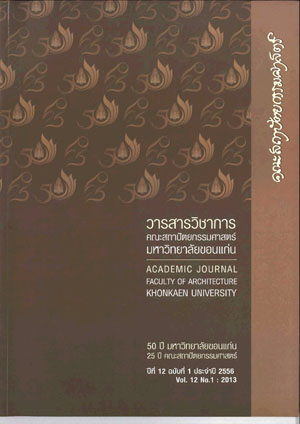บทบาทของสถาปนิกชุมชนกับการสร้างความมั่นคงในสิทธิ์การอยู่อาศัยของชาวบ้าน กรณีศึกษา ชุมชนท่าวัง
คำสำคัญ:
กระบวนการออกแบบสถาปัตยกรรม, ประสานประโยชน์, ผู้มีส่วนได้ส่วนเสีย, Architectural Design Process, Win-win Solution, Stakeholdersบทคัดย่อ
ชุมชนท่าวัง เป็นชุมชนแออัดที่อยู่ในพื้นที่รัตนโกสินทร์ชั้นในซึ่งมีความซับซ้อนต่อการพัฒนา และพื้นที่ส่วนใหญ่ของชุมชนไม่มีกรรมสิทธิ์ในการอยู่อาศัย ที่ผ่านมาหน่วยงานต่างๆมีแผนที่จะพัฒนาพื้นที่โดยขาดกระบวนการมีส่วนร่วมกับชุมชน ทำให้แนวทางการพัฒนาไม่สามารถนำมาสู่การปฏิบัติได้จริง ซึ่งปัญหานี้เป็นเรื่องสำคัญของเมืองเก่าในประเทศไทย ทำให้ผู้วิจัยในฐานะสถาปนิกที่ทำงานร่วมกับชุมชนสนใจที่จะมีส่วนร่วมในการแก้ปัญหานี้ โดยใช้กรอบแนวคิดในการวิจัยเชิงปฏิบัติการ (Action Research) ซึ่งมีโจทย์ที่สำคัญ คือ การค้นหารูปแบบการปรับปรุงชุมชนที่สมประโยชน์กับทุกฝ่ายเพื่อให้ผู้มีส่วนได้ส่วนเสียเกิดข้อตกลงร่วมกัน และสร้างความมั่นคงในกรรมสิทธิ์การอยู่อาศัยให้กับชาวชุมชน ในการนำเสนอบทความนี้จะเน้นประเด็นสำคัญ คือ การทำงานร่วมกับชุมชน และประสิทธิภาพของแบบสถาปัตยกรรมที่ใช้เป็นเครื่องมือในการสื่อสารร่วมกับผู้มีส่วนได้ส่วนเสียต่างๆ รวมถึงศักยภาพของสถาปนิกในฐานะผู้ร่วมกระบวนการแก้ปัญหาที่ทุกฝ่ายได้ประโยชน์และเกิดยอมรับแนวทางการปรับปรุงร่วมกันได้
Roles of Community Architect in Claiming the Right to Live of Community : A Case Study of Tha Wang Community
Isariya Thongchiw
Tha Wang Community, an urban-poor community in the restricted historic area of Inner Rattanakosin, has been facing complicated development conflicts and the lack of the right to live. In the past, the development projects without community participation leads them to the impractical, the important issue in all developments of historical area in Thailand. The Author, in the role of a community architect, has an interest in solving this problem through the Action research methodology to find the development that can serve the needs of all stakeholders along with claiming the right to live of community. In this article, the author will describe the process of working with community, the results of architectural design process as tools for communication among stakeholders, and also the roles of community architect as a facilitator in the negotiation to achieve the win-win solution development.
ดาวน์โหลด
รูปแบบการอ้างอิง
ฉบับ
ประเภทบทความ
สัญญาอนุญาต
ทัศนะและข้อคิดเห็นของบทความที่ปรากฏในวารสารฉบับนี้เป็นของผู้เขียนแต่ละท่าน ไม่ถือว่าเป็นทัศนะและความรับผิดชอบของกองบรรณาธิการ




